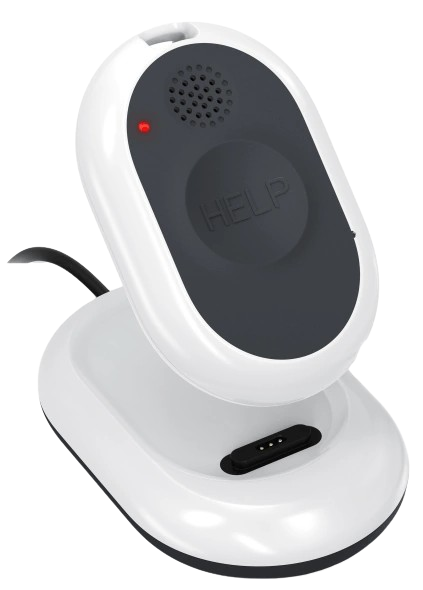Northwest Territories Lone Worker
Our Safety Policy Guide For Lone Workers In Northwest Territories
Canada’s approach to laws and workplace policies involves collaboration between federal and territorial governments. The Northwest Territories adhere to the federal Occupational Health and Safety Code for lone workers while offering region-specific suggestions to address unique working conditions.
This page will outline important practices for employers in the Northwest Territories to ensure the safety and well-being of lone workers.
On This Page
Our Guide To Lone Worker Safety Policy And Legislation In Northwest Territories
Working alone in the Northwest Territories can present notable hazards, making it critical for employers to align with both territorial and federal safety laws to protect lone workers.
This page highlights the key considerations for managing lone workers in the Northwest Territories, including adherence to hazard assessment and control measures as outlined in the Occupational Health & Safety Code (OHS).
How The Northwest Territories Defines A Lone Worker
A lone worker in the Northwest Territories is defined as someone who works at a site as the only worker or in circumstances where assistance is not readily available in case of an injury, illness, or emergency. This includes various scenarios, such as working alone at hazardous or isolated worksites, traveling alone for work, or working without direct supervision or nearby colleagues. The definition also extends to workers in client-facing roles or in environments where they may face risks, even if not physically alone.
Employing A Lone Worker In The Northwest Territories
The Northwest Territories emphasize conducting a thorough hazard assessment to identify risks specific to working alone and implementing measures to eliminate or mitigate them. Employers must establish safe work procedures tailored to the activity and environment, ensure effective communication systems (e.g., radios or phones) based on the risk level, and provide appropriate training for lone workers, including emergency response protocols.
Regular check-ins and a defined frequency of contact are crucial, particularly for high-risk or remote activities. Collaboration with workers or safety committees is encouraged to develop effective safety strategies, and equipment, procedures, and communication methods should reflect the unique challenges of working in extreme weather and remote locations.
Learn How You Can Protect Your Employees With Loneworker.com

With Loneworker.com you can be equipped with the knowledge and the means to protect your employees and protect your business. Contact us today to learn more about how Loneworker.com can protect you and your employees.
How The Safe Lone Worker App Can Protect Northwest Territories Lone Workers And Employers
An important part of keeping your lone workers safe is providing quick and easy communication and monitoring in the event of an emergency.
With the Safe Lone Worker App, you can easily monitor your employees' while they are carrying out their responsibilities, even if they are travelling alone. The app works in tandem with a man down alert button that can be pressed in the event of an emergency. If the button is pushed, the lone worker will be immediately put into contact with a monitoring center that can send help immediately and contact the employer.
Northwest Territories Lone Worker Policies
The content below has been included as a direct reference for lone worker policies as provided by Northwest Territories. This content has been included to serve as more detailed information and an easy reference point. This information is provided for your convenience, but should not be taken as legal advice. We encourage you to conduct your own research into the laws and regulations of your jurisdiction before making any decisions.
What is a code practice?
WSCC codes of practice provide practical guidance to achieve the safety requirements of the Northwest Territories and Nunavut Safety Acts and related Regulations.
As per subsection 18(3) of the Northwest Territories and Nunavut Safety Acts, “For the purpose of providing practical guidance with respect to the requirements of any provision of this Act or the regulations, the Chief Safety Officer may approve and issue such codes of practice as he or she considers are suitable for that purpose.”
WSCC codes of practice apply to workplaces in the Northwest Territories and Nunavut. The Chief Safety Officer approves codes of practice for use by all occupational health and safety (OHS) stakeholders. Codes of practice come into effect in each territory on the day they are published in the Northwest Territories Gazette and Nunavut Gazette.
Codes of practice do not have the same legal force as the Safety Acts and related Regulations. A person or employer cannot face prosecution for failing to comply with a code of practice. However, in legal proceedings under the Safety Acts and related Regulations, failure to observe a code of practice may be a consideration when determining whether a worker or employer complies with the Safety Acts and related Regulations.
Employers and workers should follow WSCC codes of practice unless there is an alternative course of action that achieves the same or better occupational health and safety outcomes.
Definitions
Competent: having knowledge, training, and skills to organize and perform tasks, or duties.
Contractor: a person or company contracted to supply products or services.
Due Diligence: taking all precautions, reasonable under the circumstances, to protect the health and safety of workers. Due diligence applies to actions before an event occurs, not after.
Employer: means every partnership, group of persons, corporation, owner, agent, principal contractor, subcontractor, manager, or other authorized person having charge of an establishment in which one or more workers perform work.
Hazard: any situation, thing, or condition that may expose a person to risk of injury or occupational disease.
Hazard Control: all steps necessary to protect workers from exposure to a substance or system, and the procedures required to monitor worker exposure and their health to hazards such as chemicals, materials, substances, or other hazards such as noise and vibration. A written workplace hazard control program should outline which methods are in use to control the exposure and the means for monitoring the effectiveness of the controls.
Hazard Identification: formal identification and documentation of hazards.
High-risk Work: work that exposes workers to hazards that, should an incident occur, may result in a fatality or permanent disability.
Imminent Danger: any place, matter, or thing which could reasonably be a source of likely danger to the health or safety of persons employed on or in connection with the work or worksite.
Incident: an unplanned, undesired event that causes or could cause injury, damage, or loss (also called accident or near miss).
Joint Occupational Health and Safety Committee: a Committee made up of equal employer and worker representation that promotes workplace safety through inspecting the workplace; identifying hazards; helping the employer develop safety policies and procedures; and making recommendations to the employer to address safety concerns.
Project Supervisor: the worker responsible for monitoring contractor safety performance; reports to the employer.
Risk: the chance or probability of a person getting harmed, or experiencing an adverse health effect if exposed to a hazard.
Working Alone: to work at a work site as the only worker, in circumstances where assistance is not readily available in the event of injury, ill health, or emergency.
Learn How The Lone Worker Monitoring Device Works.

By using a Safe Lone Worker Man Down alert you can monitoring your employees and keep them safe even while they are travelling or working on their own.
Our devices are equipped with cellular and GPS technology to provide service all across Canada and the United States of America.
Contact us today to get your Safe Lone Worker Man Down Alerts for you and your business.
Introduction
Code of practice on working alone
The Working Alone code of practice provides guidance to employers and workers to ensure the health and safety of employees who work alone. The Code provides a definition and description of working alone, outlines the legislation, and discusses hazard assessment and the development of safe work procedures. Working alone can result in hazardous situations. Employers need to develop solutions to reduce or eliminate the risks to the employee who works alone.
Working Alone refers to a range of work situations, from being the only worker in a workplace, or in a work area where the worker does not have direct contact with other employees or a supervisor, to working at a remote or isolated worksite where assistance is not readily available. Working Alone situations include:
- Working alone at hazardous work; for example in forestry, oil and gas, or a mechanicworking alone under a car.
- Travelling alone; for example, truck drivers, field workers, research scientists, surveyors, safety officers, wildlife officers, hunters, or trappers.
- Working in isolation; for example, custodians and security guards or maintenance workers.
- Meeting clients away from the office; for example, home care workers, nurses, government enforcement officers, social service workers, or real estate agents.
- Working alone and handling cash; for example, convenience store clerks, retail service and food outlet workers, or taxi drivers.
This Code of Practice does not cover the specific circumstances of employees who work alone or at an isolated work site or describe monitoring methods for particular situations. Employers are responsible for considering and addressing all the hazards in jobs where workers work alone or in isolation by reducing or eliminating the risks. They must implement safe work procedures and train their employees to use them. Safe work procedures can cover a wide variety of scenarios. Some situations deal with the hazards that dangerous machinery and toxic materials present. Other situations present risks to the worker’s psychological well-being due to threat of violence, or the impact of the isolation when working in a remote location. The employer must consider all these factors when developing safe work and emergency response procedures.
Acts, Regulation and standards
Employers, supervisors, and workers need to be aware of the legal responsibility associated with ensuring safety as an integral part of workplace activity, and the consequences if they do not meet safety obligations in addition to injuries or damages to property or materials. Under territorial legislation, employers, supervisors, and workers may be subject to financial and imprisonment penalties.
Northwest Territories and Nunavut Safety Acts
Health and Safety
4. (1) Every employer shall
(a) maintain his or her establishment in such a manner that the health and safety of persons in the establishment are not likely to be endangered;
(b) take all reasonable precautions and adopt and carry out all reasonable techniques and procedures to ensure the health and safety of every person in his or her establishment;and
(c) provide the first aid service requirements set out in the regulations pertaining to his or her class of establishment.
(2) If two or more employers have charge of an establishment, the principal contractor or, if there is no principal contractor, the owner of the establishment, shall coordinate the activities of the employers in the establishment to ensure compliance with subsection 4(1).
5. Every worker employed on or in connection with an establishment shall, in the course of his or her employment,
(a) take all reasonable precautions to ensure his or her own safety and the safety of other persons in the establishment; and
(b) as the circumstances require, use devices and articles of clothing or equipment that are intended for his or her protection and provided to the worker by his or her employer, or required pursuant to the regulations to be used or worn by the worker.
Northwest Territories and Nunavut Occupational Health and Safety Regulations
Part 3 General Duties
33. (1) In this section, "work alone" means to work at a work site as the only worker at that work site, in circumstances where assistance is not readily available in the event of injury, ill health or emergency.
(2) If a worker is required or permitted to work alone or at an isolated work site, an employer, in consultation with the Committee or representative or, if no Committee or representative is available, the worker and other workers, shall identify the hazards arising from the conditions and circumstances of that work.
(3) An employer shall take reasonable measures to eliminate or reduce the risks posed by the hazards identified under subsection (2), including the establishment of an effective communication system that consists of
(a) radio communication;
(b) phone or cellular phone communication; or
(c) any other means that provides effective communication considering the risks involved
Key Working Alone Concepts
Hazard Assesment
Identify the risks arising from the conditions and circumstances of the work site in consultation with the Joint Occupational Health and Safety Committee, including input from the worker, in order to reduce the probability of an incident. Refer to the Hazard Assessment code of practice.
Eliminate or reduce the risk
Take all reasonable measures to eliminate the risks identified, which include the development of safe work procedures, establishment of an effective communication system, training of workers, and ensuring access to emergency services in case of injury or incident.
Key steps to follow:
1. Do a Hazard Assessment.
2. Identify the Risks in Working Alone.
3. Establish Safe Work Procedures.
4. Keep Work Alone Procedures Current.
Hazards of working alone
In the Northwest Territories and Nunavut, challenging weather conditions, remote and isolated work sites, mobile phone and internet access limitations, hazardous work, shortage of workers, and a transient workforce contribute to risk for employees working alone.
Certain circumstances make working alone hazardous. Identifying the hazards inherent to these circumstances depends on accurately defining what working alone is, and evaluating the situation and the degree of risk. Whether a situation poses a high or low risk will depend on the type of work activity, the work environment, and the potential consequences of an emergency, accident, or injury. The wide range of factors makes it important to assess hazards specific to each work alone situation; determine the level of risk; and consider the employee’s knowledge, skills, and training.
Working Alone or Working in Isolation describes situations when a worker performs a job function during the course of employment, where they:
Are the only worker for the employer at a workplace at any time;
Work at a worksite remote from other workers;
Work in circumstances where assistance is not readily available;
Do not have direct supervision by the employer or a supervisor;
Are not in the presence of another employee directly associated with the same employer;
Work in an area where the worker does not have visual contact with a co-worker; or
Travel away from a base office to perform job tasks; for example, client meetings.
When working alone is not being alone
It is important to recognize working alone hazards can exist in situations beyond being alone at a work site or working in isolation. Unique hazards arise for workers who travel for work or meet clients away from their office. A social worker, health care worker, or security worker – though not alone in person – may still be considered to be working alone. Even when surrounded by other people, a work situation may meet the conditions described in the section above.
Travel Hazards
Employees who travel alone may be exposed to the risks of injury from a vehicle accident, extreme weather conditions, or getting stranded in remote areas. Doing fieldwork alone carries a degree of risk in relation to the location and access to communication and emergency response. A businessperson in transit presents a low risk scenario, while an investigator alone in an isolated location may face a higher degree of risk in view of potential hazards.
Hazard Assessment
The employer must identify workplace hazards to ensure the health and safety of the employee who works alone. Determining the level of risk involved with the type of activity, task, and environment helps form safe work procedures and develop controls to eliminate or reduce the risks.
Worker Involvement
A worker representative must participate in assessing the hazards and risks and developing the necessary controls. Employers must inform affected workers of the hazards identified and the methods they will use to control or eliminate the hazards in working alone. The worker should also receive a copy of the hazard assessment.
Factors to consider in hazard Identification
Locations where employees work alone.
Type of work activity (for example, welding).
Hazards inherent to the work activity (for example, equipment failure, toxic gasses).
Hazards inherent to the work environment (for example, heat, cold, hostility, drug abuse).
Previous incidents, injuries, reports, and near misses.
Control measures and precautions currently in use.
Details on how to seek or provide emergency assistance.
Evacuation and emergency procedures.
Equipment needed for employees working alone.
Information and training provided to the worker.
Gaps or patterns to address.
Level of Risk
Risk is the chance or probability of the worker getting harmed or experiencing an adverse health effect if exposed to a hazard. Evaluating the risks as low, medium, or high ensures the appropriate measures of controlling the hazards.
Factors to consider for Level of Risk:
Hazard of work activity and job function.
Hazards of the environment and conditions.
Length of time the worker works alone.
Access to emergency services.
Access to effective communication.
Important variances in risk Assessment
Consider whether the worker has permission to work alone while performing a specific work activity. With certain jobs, such as confined spaces, the risk is too high to permit a worker to work alone. The work environment also impacts the level of risk. Security work in a mall may be high risk in certain locations. A nurse working alone in an isolated location may be at higher risk than the job function predicates. Working with dangerous equipment in a remote location, which emergency services cannot immediately access, carries significant risk, as does working alone with dangerous equipment in a workshop at night without a check-in arrangement.
Thermal condition in the northwest territories and nunavut
Conditions like heat and cold present various levels of risk to someone working alone. A work activity that may not pose a risk in ordinary circumstances can become a high-risk activity in extreme weather conditions, such as what occur in the NWT and Nunavut.
Truck driving in other localities or in the summer season may be low risk, but in tuckers in the NWT often drive alone, with long distances between settlements, minimum communications contact by radio, and in hazardous snow and ice conditions that vary by the hour. Ice roads are especially dangerous in spring and fall, and incidents involving trucks breaking through ice occur every year.
Furthermore, extreme cold affects machinery. Equipment is prone to break down at extreme temperatures. In the NWT and Nunavut where life may depend on repairs and maintenance despite weather conditions, this impacts risk assessment. For instance, safety harnesses are tested to comply with standards ranging down to only -35°C.
High risk examples
Working with:
High energy materials (radioactive, high temperature).
Toxic gases, liquids, or solids.
Cryogenic (low temperature) materials/processes.
High pressure systems.
High voltage electrical systems
Logging industries.
Moving equipment or machinery.
Laboratory functions.
Working in:
Extreme weather conditions with winter road construction and maintenance.
Remote locations with limited emergency access (for example, surveying, logging, hunting, fishing).
Workplaces isolated from public view and at risk of violent attack (for example, guards).
Situations requiring the handling or transferring of flammable liquids, for instance in the oil and gas industries.
Occupations that require travel away from an office base such as wildlife officers, or to meet clients, such as care workers and law enforcement officers.
Environments where the job functions may not be hazardous, but employees are at risk of criminal victimization because they handle cash or goods. Examples include, but are not limited to, late night convenience stores, taxi transport, and gas station services.
Low Risk Examples
Working in:
Maintenance, other than on active processing equipment.
Security, except in hazardous locations.
Janitorial or custodial positions, except when location is hazardous.
Transportation; that is trucking under ideal conditions.
Offices or while in transit on a business trip.
The Hazard Assessment Code of Practice provides more detail on risk factors and assessment. The purpose of the assessment is to develop appropriate controls to prevent harm or injury.
1. Elimination (remove from the work site)
2. Substitution (use a less harmful chemical)
3. Engineering (isolate equipment /set guards)
4. Administration (provide training/ maintenance/ safe work procedures)
5. Personal Protective Equipment (provide gloves/ goggles/ safety harness)
After conducting an assessment that identifies all the hazards, develop procedures to address how to control each hazard to eliminate or manage risk. When working alone or in isolation, developing a safe work procedure specific to the job is an essential control and safety measure, particularly where multiple factors come into play, such as a vast range of occupations, job functions, and environmental conditions.
Safe Work Procedures
After all hazards have been identified, reducing risks requires safety measures and systems suitable to the worker’s needs. Before any employee can work alone or in isolation, employers must develop a procedure that both the employer and employee sign. Each working alone activity requires procedures specific to that activity and work environment. The worker must have adequate training in the use of the equipment, systems, and procedures for their effective application.
Working alone in the North includes outside jobs such as winter road construction, maintenance, transportation, water delivery, municipal services, conservation, exploration, and hunting and trapping. Adjust safe work procedures and training for working alone to reflect the North.
Worker Consulation
Consulting with the joint occupational health and safety committee (JOHSC) representing the worker, or with the worker directly is key to developing and successfully implementing safe work practices. Workers experience the hazards first hand and can help identify controls.
Effective Communication
Written safe work procedures must include an effective communication system and a way for employees to get help if there is an incident. The communications system must be responsive to the type and level of risk of the work and worksite. For instance, the employer of a surveyor who completes fieldwork alone could supply them with a hand held radio and schedule a check in every half hour.
The three main components of effective communication are the frequency of check-in, dependability of the system, and training.
Effective communication systems include:
Radio communication;
Phone or cellular communication; and
Any means that provide effective communication considering the risks involved (for example, satellite phone, two-way radios, silent alarms).
Effective communication may require constant or intermittent mechanical or electrical surveillance or use of security systems, personal pagers, two-way radios, emergency sounding devices, visual monitoring systems, or similar equipment. Post telephone numbers of the regular and emergency contacts in easily visible locations.
Frequency Of Contact
The level of risk identified in the hazard assessment will determine the frequency of check-in or call-in times to make contact with the worker. Using the telephone for communication at regular intervals may be adequate in low risk situations. For personnel working in high hazard environments or at night in work environments that attract criminal victimization, check-in would be more frequent.
Presonal Check-In By Another Person
Check-ins scheduled at regular intervals ensures the safety and well-being of the employee working alone. Check-in procedures must clearly define time intervals (time between check-ins), shift end check-in, and procedures to follow when you cannot contact the worker. The employer, another employee, or the person the employer designates to check on the employee who is working alone, must know about that employee’s activities and be capable of putting the emergency response plan into effect.
Training
The employer needs to provide adequate information, instruction, and training to ensure competent and effective responses to working alone hazards. Even for low hazard activities, such as office work, the employee must receive instruction on safe work procedures for working alone. Working alone and outside in extreme weather conditions requires specific training and preparation; even more so in remote communities and locations.
All employees working alone require training in an effective communication system and call-in procedures. Additional training will depend on job function, job requirements, location, level of isolation, and environment of the working alone situation. For instance:
Hazardous / Remote Work: Equipment safety, use of personal protective equipment, first aid, travel procedures.
Travelling Alone: Safe work procedures, emergency survival training, travel procedures.
Late Night Retail: Money-handling procedures; dealing with shoplifting, robbery, irate or abusive customers; emergency procedures.
Secure Facility: Measures to reduce the risk of violence and procedures for dealing with violent situations.
Incident Reporting
The employee needs to keep accurate accounts of any incident that occurs while working alone (what happened, where it happened, why it happened, who it happened to, any witnesses, any other relevant information). The employee reports the incident to the employer who must report serious workplace incidents and injuries to the WSCC. Evaluating the incident report can lead to improved working alone procedures and policies.
References
WSCC. NORTHWEST TERRITORIES and NUNAVUT CODES OF PRACTICE. Sept. 2016.
Government of Canada, Canadian Centre for Occupational Health and Safety. Working Alone - General. 10 May 2024.
Loneworker.com is an aggregate resource and is not directly affiliated with government policies, legislation, or guidelines. Our site is intended to gather and display information for your use, but you are encouraged to conduct your own research.
Northwest Territories Lone Worker Resources

WSCC - Workers' Safety & Compensation Commission
Yellowknife:
- 867-920-3888
Toll free:
- 1-800-661-0792

Lone Worker And Employment Facts In Northwest Territories
22,800 People Are Employed In The Northwest Territories
Forestry, Fishing, Mining, Quarrying, Oil and Gas Make Up The Majority Of The Northwest Territories’ Employment Industry
Affordable Monitoring For Lone Workers In Northwest Territories

-
 Monitoring Your Employees' Safety
Monitoring Your Employees' Safety
-
 GPS Tracking And Monitoring
GPS Tracking And Monitoring
-
 Man Down Panic Alerts
Man Down Panic Alerts
-
 24/7 Protection Anywhere
24/7 Protection Anywhere
Lone Worker Legislation
Lone Worker Safety Policies And Legislation By Province
-
 Alberta Provincial Safety Policies And Legislation
Alberta Provincial Safety Policies And Legislation
-
 British Columbia Provincial Safety Policies And Legislation
British Columbia Provincial Safety Policies And Legislation
-
 Manitoba Provincial Safety Policies And Legislation
Manitoba Provincial Safety Policies And Legislation
-
 New Brunswick Provincial Safety Policies And Legislation
New Brunswick Provincial Safety Policies And Legislation
-
 Newfoundland and Labrador Provincial Safety Policies And Legislation
Newfoundland and Labrador Provincial Safety Policies And Legislation
-
 Nova Scotia Provincial Safety Policies And Legislation
Nova Scotia Provincial Safety Policies And Legislation
-
 Ontario Provincial Safety Policies And Legislation
Ontario Provincial Safety Policies And Legislation
-
 Prince Edward Island Provincial Safety Policies And Legislation
Prince Edward Island Provincial Safety Policies And Legislation
-
 Quebec Provincial Safety Policies And Legislation
Quebec Provincial Safety Policies And Legislation
-
 Saskatchewan Provincial Safety Policies And Legislation
Saskatchewan Provincial Safety Policies And Legislation
-
 Northwest Territories Provincial Safety Policies And Legislation
Northwest Territories Provincial Safety Policies And Legislation
-
 Nunavut Provincial Safety Policies And Legislation
Nunavut Provincial Safety Policies And Legislation
-
 Yukon Provincial Safety Policies And Legislation
Yukon Provincial Safety Policies And Legislation







